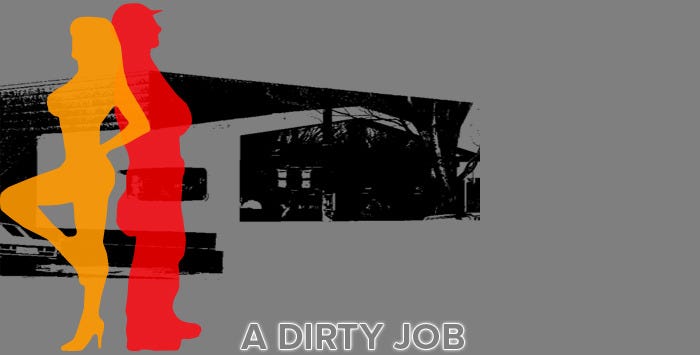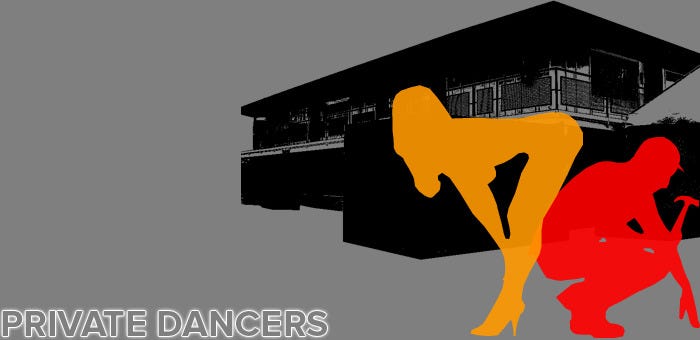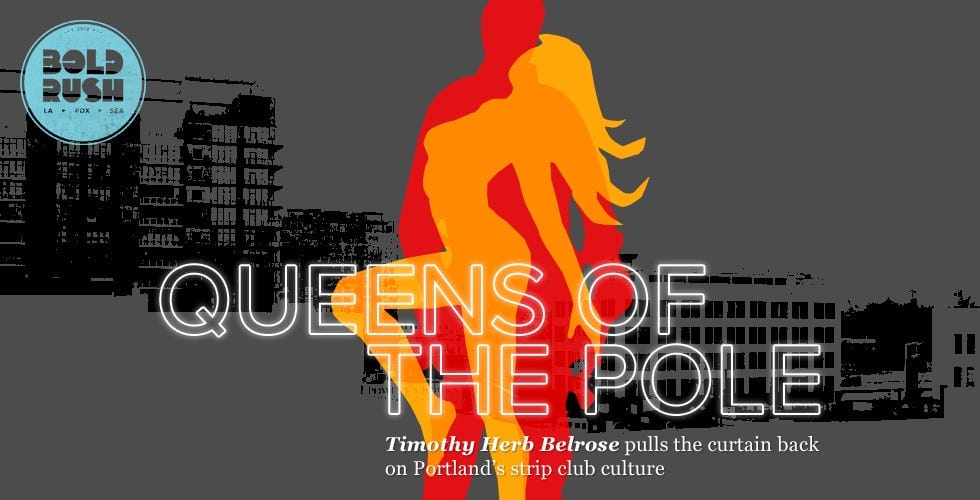
Many cultural phenomena set Portland apart from other cities, and the strangest is that every neighborhood has a grocery store, a restaurant, a bike shop, and a strip club. There are competing theories as to why there are so many strip clubs here. Some say it originates with the white-clad sailors of lore who no longer walk the streets except during Fleet Week when battleships line the riverbank. Others blame the infamous scapegoat “the rain” (also the local patsy for copious coffee consumption and ubiquitous indie movie theaters) or the liberal Northwest tendencies that promote freedom and expression.
A wise old-schooler told me that in the ’90s the Oregon Supreme Court ruled that nudity is protected free speech. Before that, he said, there were only two “titty bars” in Portland. After the ruling, every bar struggling for money stuck a pole in the corner, blacked out the windows, and dimmed the lights. Voilà! The law forbade contact between the dancer and the customer, so the performance here often reflects the tradition of burlesque performance; different from the aggressive bump-and-grind-style clubs of Las Vegas, East St. Louis, or Tampa.
When you live in a middle-sized city that has so many erotic dancers you are bound to see them all over the place. It’s all about picking out the symbols. Like the girl with bedhead at the bus stop in pajamas at three in the afternoon with rolling luggage headed in the opposite direction of the airport. Or the Goth lady with the giant Mohawk driving a 1965 Barracuda with a two-foot lizard sitting on her lap. Or your friend who says that she makes $450 a night bartending at “some bar you’ve never heard of” on 82nd Avenue. These are the telltale signs.


I got an insider’s perspective when I moved into an apartment in southeast Portland after finishing college in Colorado. With bills to pay and no one knocking down my door to hire a 23-year-old writer with a liberal arts degree, I began asking around for any work that I could find. A neighbor whom I had impressed with the skills I gleaned from eighth grade woodshop took me over to one of his hairdressing client’s homes.
Inside, I met a large, chain-smoking middle-aged man who had immigrated from the Eastern bloc in his teenage years. We sat at his table and stared at a giant grid of closed-circuit video feeds of live footage from the club on a flat-screen TV mounted over his kitchen counter. The gaze of electronic eyeballs followed every pore, every crumpled dollar stuffed into a G-string, and, contrary to workplace privacy law, every shower and costume change in the dancers’ dressing room. With a remote control in one hand and a cigarette in the other, this pasty man controlled his own bawdy reality TV show.
I sat transfixed. I was a statistic, another young creative dreamer who came to Portland for the greenery and progressiveness and stayed for the unemployment. Desperate for income and willing to give anything a shot to make some dough, I soon became his most trusted employee. I could do no wrong in his eyes, and he would remark to others about the quality of my work and the strength of my vision.
He called me not by my name, but by a formal title: the Carpenter.
My job was to put in a new floor and base molding in the dressing room of one of the strip clubs. I planned to start early and retire before the dancers arrived, but the owner asked that I not start before 9 a.m. To make matters worse he formulated a complicated multipiece baseboard with bead moldings, chamfers, and dentils to be installed in an ascending order of black, gold, red, black. This was to accentuate the red and black tile floor, the red walls, the black ceilings, the red velvet curtains and the gold sconces. I would soon complete the details of his vision — a grand motif stolen from the color palette of cut-rate Chinese furniture.


Around 11 a.m. the dancers strolled in with rolling suitcases, wearing pajamas. One by one they stopped dead in their tracks at the sight of a man in their sanctum. They would call the boss and complain on his voicemail. He would reply stoically through the PA system connected wirelessly to his home, “Please do not interrupt the Carpenter. He has much work to do.” And then he would add, “And please do not smoke outside the club in your underwear, it makes you all look like hookers.”
They ignored me and then became comfortable with my presence. Between rounds of providing entertainment for the lunch crowd, they made small talk. I crouched on my hands and knees gluing and tediously nailing tiny pieces of pigmented mitered wood to the wall. My fingertips often bled. They sat in their miniskirts, leather bustiers, fishnets, and five-inch tall heels sedately smoking cigarettes and watching me. In the backward, shifting ways of our karmic world, I had become their entertainment.
They talked. About the time Mercedes walked off the stage and took home the guitar player from Jane’s Addiction. The time Roxy did too much cocaine, had sex with a customer all night, got scared, took a handful of morning-after pills and then puked between her dance sets for the next four days. I heard countless professional and educational plans on how to leave the sex industry. I noted how the older dancers felt threatened by the young and staked out their territory with pointy fingernails and veiled threats. I learned by hearsay that there were many bitches in this business. It seemed everyone was a bitch or a cunt when they were not around, but in one another’s presence they were all Queens of the Pole.


I drank heavy doses of coffee and tried to increase the pace of my work. The darkness of the room began to blot out the sunshine in my heart. Three weeks into the job, my competence faltered. The smoke, the lingerie, tattoos, thigh-high platform boots, and piles of sweaty spandex clouded my perception. I was a fly on the wall in hell, shriveled up and dying from the perfume-scented heat.
I looked up and saw a starved, desperate wolf staring back at me from the prismatic banks of makeup mirrors. I pulled myself up by the straps of my boots and finished the last pieces of trim. With stringy holes wearing through the knees of my jeans I packed up my tools, swept up the sawdust, and said good-bye to my new friends with a kiss on each cheek and a stack of dollar bills on the rail. I did not return.
Carpentry is hard work. It is hard on the body and tiring on the mind. It’s probably not half as hard as dancing for 12 hours a day in front of lonesome strangers. Stripping is a dirty, inglorious job. It’s not easy to crawl around the floor naked, shimmy up and down a greasy brass pole while Slayer blasts in your ear and try to look sexy. It puts food on the table and gas in the tank. It pays a few bills. Some women no doubt enjoy it, and others feel trapped by it just like everyone else does at some point in their career. Working there I saw Sleeping Beauty smoking a cigarette and coughing behind the façade of her Magic Kingdom. The illusion was eternally broken for me.
All I see in strip clubs now is sales, marketing, and bad carpentry.

Editor’s note: This content is part of The Bold Italic’s West Coast Bold Rush tour. Come see us in Portland Oct. 2–3 for our pop-up shop and ping-pong party if you’re in the NW.








